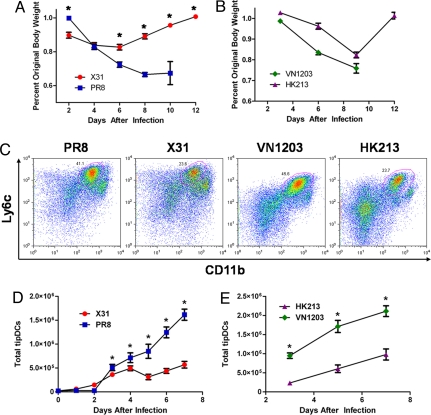Fig. 1.
Increased pathology correlates with greater tipDC recruitment. (A and B) Host morbidity presented as mean of percentage original body weight ± SEM after infection with PR8 (lethal H1N1) or x-31 (sublethal H3N2) (A) and VN1203 (lethal H5N1) or HK213 (sublethal H5N1) (B). In general, mice infected with x-31 lose less weight than mice infected with PR8 (asterisks, simple effects ANOVA, P < 0.05). For the H5N1 viruses, HK213-infected mice lose less weight than VN1203-infected mice (virus effect, P < 0.0001). Results are representative of at least 3 independent experiments (n ≥ 5). (C) Representative FACS plots for total lung homogenate stained with mAbs to Ly6c and CD11b on day 5 after infection with PR8, x-31, VN1203, or HK213. The gated population (circled in red) from each plot represents tipDCs. (D and E) Mean number of tipDCs ± SEM recovered from total lung homogenate over time after infection with PR8 or x-31 (D) and VN1203 or HK213 (E). Sublethal infections resulted in fewer tipDCs in the lungs on days marked with an asterisk (simple effects ANOVA, P < 0.03). Results are representative of at least 3 independent experiments (n ≥ 5).

